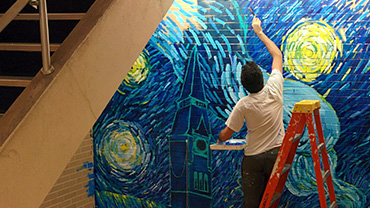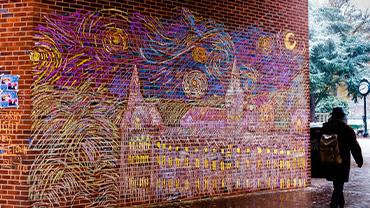
The idea came to Agree Ahmed (SFS ’15) in the form of a surprisingly blank canvas at the end of 2013. “It was my first winter at Georgetown,” he remembered. “One day, before finals, I noticed that all the posters alongside the tunnel in Red Square had been taken down.” Ahmed, who was pursuing a B.S. in Foreign Service, had taken up drawing and painting as a hobby and saw a unique chance to flex his creative muscles. “It’s very rare for that heavily-trafficked space to be completely blank, so I immediately thought, ‘What could I do with that?’”
Ahmed’s mind quickly flew to the Dutch post-Impressionist Vincent Van Gogh and his magnum opus, “The Starry Night.” He saw Van Gogh as a sort of cultural broker; his work an iconic access point for modern audiences to appreciate 19th century art. It helped that “Starry Night” already had a well-established memetic quality to it, its signature swirling skyline being both instantly recognizable and easily duplicated over other locations. In his first sketches of “Starry Night Over Georgetown,” Ahmed struggled to fit the whole campus and Key Bridge into one composition. “I ended up radically simplifying it and just focusing on Healy Hall,” he said. “It’s the face of the university, and the tower is similar to the cypress tree in the original.”
When it came time to recreate Van Gogh’s masterpiece in Red Square, Ahmed wanted to keep his work discrete. “I didn’t want to be directly associated with it,” he said. “Georgetown’s a small-enough campus that I thought it might come off as egotistical to commandeer this big space or make it about myself. I wanted to see how people reacted to it without my name being attached or friends knowing.” So, one evening just before the end of an event with the Philodemic Society, Ahmed ducked out into the night, picked up a ladder and some chalk, and headed to his brick canvas.
As the morning unveiled his towering chalk mural, Ahmed watched the wave of responses online. “Immediately, I started seeing photos on Facebook–back when we used Facebook,” he added. “People were making it their cover photos and asking, ‘Who did this?’” When Ahmed’s parents visited soon after, he took them to visit the mural on the condition that they wouldn’t reveal his part in its creation. “My mom was looking at it, and there were people stopping to take photos while she was there. That’s when I was like: ‘Okay, cool. This resonated.’”

Unfortunately, while Ahmed’s anonymous art garnered local praise, support for creativity on campus had been dealt a heavy blow. In October 2013, The Hoya announced that Reimagine Georgetown, an initiative founded in 2007 to fund student-led artistic and community projects, was being discontinued. A collaboration between Georgetown University, GUASFCU, The Corp and The Hoya, Reimagine Georgetown had funded several successful projects over the years but struggled to overcome logistical challenges in consistently delivering grant funds.
Even so, Reimagine Georgetown still had enough funds left over to support a handful of projects. When Ahmed finally shared his secret with a few friends, one convinced him to come forward and suggest a more permanent rendition of “Starry Night Over Georgetown.”
In November 2013, more than a year after Reimagine Georgetown was discontinued, Students of Georgetown, Inc. and the Georgetown University Alumni and Student Federal Credit Union announced they would distribute the remaining funds to fund two new murals: one along the wall in front of Yates Field House, and another in Lauinger Library’s stairwell between the second and third floors, where Ahmed would translate his tribute to the Dutch master.
Two years later in spring 2015, he once again approached a brick canvas, this time clutching buckets of paint that had previously been beyond his budget. He was given a ladder and the three weeks before, during, and after spring break to make “Starry Night” shine again, even as students shuffled around his paint-splattered work space in Lau’s stairwell. To motivate himself early on, he took his brush and inscribed a quote from rapper Jay-Z in an empty corner: “Difficult takes a day, impossible takes a week.”
With the promise of greater permanence for his art, came higher stakes. Determined to leave behind a polished work, Ahmed created a perspective grid on the wall, mounting string with putty to make guidelines for Healy’s facade. As he slowly covered the bricks in blue and gold, some of his brushstrokes leapt across to the adjoining walls, creating the illusion of the mural’s world spilling out into the viewer’s. By the time he was finished, the stairwell was positively transformed from a vacant, stony passage into a dreamy gateway. It depicted the campus’ most recognizable landmark through the eyes of an artist whose vision has stood the test of time, welcoming students into the most popular study space on campus. Impossible had ultimately taken three weeks after all, but Ahmed was satisfied.
While he hasn’t gone on to become a painter, Ahmed’s current work often calls upon his combination of determination and creativity. As the co-founder of NUMI, a company that connects startups with professional designers, he finds himself drawing upon his artistic experience “much more than I would have expected if you asked me back when I was a student,” he said.
Today, his mural is one of many student artworks spread throughout the library, with Hoyas’ paintings, photographs, prints, and posters rotating through its many exhibits year after year. With significant renovations on the horizon, library leadership is hesitant to greenlight more lasting displays like Ahmed’s until they can be guaranteed a more permanent spot in the library. Dean Harriette Hemmasi and other librarians celebrate the creative work of students, recognizing that student art helps bring life to Lauinger now and into the future. “Our library has always been a place where students can learn, create, and connect with each other,” Hemmasi said. “I see a lot of potential and value in students helping with the transformation of library spaces, just as Agree transformed Lau’s stairwell almost a decade ago.”
Looking back, Agree is grateful to have left his mark on that particular stairwell, as it now frequently greets students at the beginning and end of strenuous late-night study sessions on the second floor. “It’s a place where a lot of students have core memories of walking in to cram for a final and walking out bleary-eyed at 3 or 4 a.m.,” he said. “I always envisioned that somebody having that experience would walk out of the second floor, climb up those stairs, crane their head up, and see ‘Starry Night,’ and maybe it would help them feel inspired. That was always my hope.”
